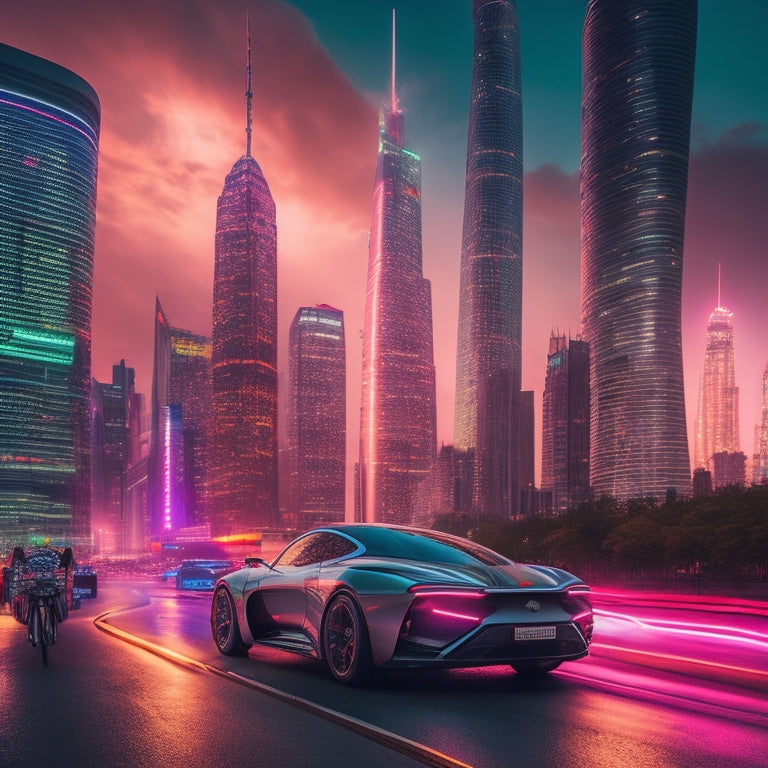
China's Electric Vehicle Industry Reigns Supreme
Share
China's electric vehicle (EV) industry has emerged as a global leader, driven by a favorable policy environment, technological innovations, and strategic investments. With over 6.8 million units sold in 2022, China dominates the global EV market. The government's support, including over 200 billion RMB in subsidies and tax breaks, has fostered innovation and adoption. The development of LFP battery technology has been a key factor, offering higher energy density, improved safety, and lower production costs. As the industry continues to evolve, a deeper exploration of these factors and their implications provides valuable insights into China's EV success story.
Key Takeaways
• China dominates the global EV market with over 6.8 million units sold in 2022, driven by a supportive policy environment and innovative technology.
• The Chinese government has invested over 200 billion RMB in EV subsidies and tax breaks, fostering industry growth and innovation.
• LFP battery technology, pioneered by Chinese firms like CATL, offers improved safety, higher energy density, and lower production costs, making EVs more affordable.
• The global EV market is expected to accelerate, driven by declining battery costs, emissions regulations, and emerging market growth opportunities.
• Chinese EV companies are poised for expansion, with a focus on brand differentiation, competitive pricing, and strategic partnerships to stay ahead in a competitive market.
China's EV Dominance Explained
China's emergence as the world's leading electric vehicle (EV) market can be attributed to a combination of strategic government initiatives, investments in battery technology, and a supportive policy environment that has enabled domestic companies to thrive.
This synergy has driven China's EV sales to surpass 6.8 million in 2022, accounting for over half of global EV sales. The policy impact has been significant, fostering an ecosystem that encourages innovation and adoption.
Technology innovation, particularly in battery technology, has been an essential factor in China's EV success. The development of LFP batteries, pioneered by Chinese firms, has made EVs more affordable and accessible.
This perfect storm of policy and technology innovation has propelled China to the forefront of the global EV industry.
Government Support and Incentives
The Chinese government's provision of over 200 billion RMB in EV subsidies and tax breaks from 2009 to 2022 played a significant role in fostering a supportive ecosystem for domestic EV companies. This policy impact has been instrumental in driving economic growth, with the EV industry becoming a key contributor to China's GDP.
The subsidy effects have been far-reaching, facilitating industry development and encouraging innovation. By providing financial support and procurement contracts, the government has enabled EV companies to invest in research and development, leading to advancements in battery technology and manufacturing processes.
As a result, China has emerged as a global leader in the EV industry, with its companies poised for continued growth and expansion.
The Rise of LFP Battery Technology
Lithium-iron-phosphate (LFP) batteries, pioneered by Chinese firms, have become a cornerstone of the country's electric vehicle (EV) success, offering a safer, cheaper, and energy-dense alternative to traditional battery chemistries. This battery innovation has played a significant role in the popularity and growth of Chinese EVs.
Key advantages of LFP batteries include:
- Higher energy density, enabling longer driving ranges
- Improved safety features, reducing the risk of thermal runaway
- Lower production costs, making EVs more affordable
- Enhanced recyclability, reducing environmental impact
Chinese battery companies like CATL lead innovation in LFP technology, contributing to cheaper and more abundant EV batteries. As the EV industry continues to evolve, the development of LFP batteries will remain essential in driving growth and adoption.
Global EV Market Opportunities
Electric vehicle adoption is poised to accelerate globally, driven by increasingly stringent emissions regulations, declining battery costs, and growing consumer acceptance.
As EV market trends continue to emerge, sustainable mobility innovations are gaining traction. Governments worldwide are implementing policies to encourage EV adoption, such as tax incentives and investments in charging infrastructure.
Emerging markets, particularly in Asia and Latin America, present significant opportunities for EV growth. China's dominance in the EV industry serves as a model for other countries to follow, highlighting the importance of government support, investment in battery technology, and innovative marketing strategies.
As the global EV market continues to evolve, new opportunities for sustainable mobility innovations will arise, shaping the future of transportation.
Market Competition Heats Up
Competition in the electric vehicle market is intensifying, driven by the entry of new players, increased investment in research and development, and aggressive marketing strategies. As a result, established brands are facing pressure to innovate and adapt to stay ahead.
To stand out in a crowded market, companies are focusing on:
-
Brand differentiation: Developing unique features, designs, and brand identities to attract customers.
-
Competitive pricing: Offering affordable options to appeal to a wider range of consumers.
-
Innovative technology: Investing in research and development to improve range, efficiency, and performance.
- Strategic partnerships: Collaborating with other companies to expand offerings and reach new markets.
As competition heats up, companies that can effectively balance innovation, pricing, and branding will emerge as leaders in the electric vehicle market.
Going Global, Adapting Strategies
Chinese EV companies, having initiated their journey into the international territories, are now venturing into international territories, necessitating strategic adaptations to navigate diverse regulatory environments and consumer preferences.
As they start on global expansion, they must tailor marketing tactics to resonate with local audiences. In Europe, for instance, Chinese EV brands will need to emphasize their eco-friendliness to appeal to environmentally conscious consumers. In contrast, in emerging markets, they may focus on affordability and accessibility.
China's EV Industry Outlook
Monitoring these developments and their impact on the market is crucial as China's EV industry nears saturation in the domestic market and gears up for a new phase of growth driven by increasing exports, technological advancements, and emerging trends in the mobility sector.
Several key factors will shape the industry's outlook:
- Increasing exports to countries with growing demand for EVs
- Continued investment in research and development to drive technological advancements
- Integration of emerging technologies like autonomous driving and Vehicle-to-Everything (V2X) communication
- Expansion into new markets and segments, such as electric buses and trucks
These trends will drive China's EV industry growth and strengthen its position as a global leader in the sector.
As the industry evolves, monitoring these developments and their impact on the market becomes crucial.
Frequently Asked Questions
How Does China's EV Industry Impact Its Air Quality and Pollution Levels?
China's electric vehicle industry notably contributes to emissions reduction, with a 2022 study indicating a 12.6% decrease in urban air pollutants, thanks to urban planning strategies and EV adoption, resulting in improved air quality and reduced pollution levels.
Can Other Countries Replicate China's EV Success Without Government Support?
As the EV landscape unfolds, the question looms: can others replicate China's success without government support? Market dynamics and economic incentives hold the key; without these, the road to EV supremacy remains shrouded in uncertainty.
Will LFP Battery Technology Become the Global Standard for Evs?
LFP battery technology's advantages, including safety, affordability, and energy density, position it as a strong contender for global EV standardization, leveraging its battery superiority to drive widespread adoption and reshape the EV landscape.
How Will Chinese EV Companies Overcome Language Barriers in Global Expansion?
To overcome language barriers in global expansion, Chinese EV companies can invest in cultural immersion programs and language training for employees, ensuring effective communication and adaptation to diverse markets, fostering global success.
Will China's EV Industry Growth Slow Down With Decreasing Government Subsidies?
As government subsidies decrease, China's EV industry growth may slow due to market volatility, but consumer behavior, driven by increasing environmental awareness and cost savings, is expected to sustain demand and mitigate the impact of reduced subsidies.
Related Posts
-

3 Best Eco-Grants for Home Energy Upgrades
You're eligible for various eco-grants that can help you cut down on energy bills and reduce your carbon footprint by...
-

7 Best EV Battery Health Trackers for Homeowners
You can maximize your electric vehicle's performance and lifespan by leveraging advanced battery health trackers that...
-

Why Merge Earth's Heat With Sun's Energy?
You're about to utilize the full potential of renewable energy by combining the Earth's natural heat with the Sun's a...


